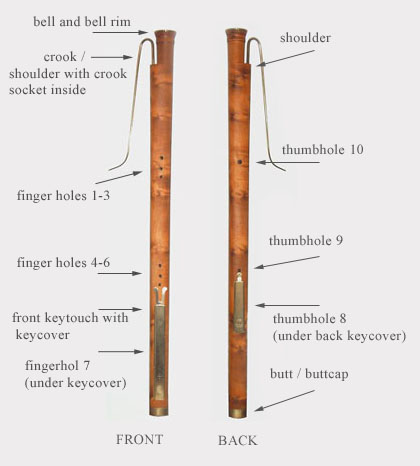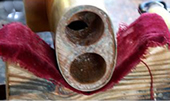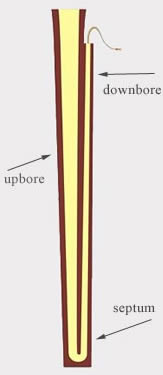Structure and Playing Technique of the Dulcian
Dulcians are usually made of maple or sycamore although cherrywood, cedar, ebony, oak, rosewood or walnut have been used with varying success.
The distinguishing feature of the dulcian is its conical double bore (fig. 1): a smaller, smoothly tapered downbore, started from one end of the workpiece, and a broader upbore, started from the other end and ending into the bell. The two bores should lie as close as possible to each other, but not too close as to weaken the instrument and not too far lest it be clumsy to handle. The bell is turned on a lathe, either integral with the body or turned from a separate piece of wood.

There are principally three forms of bells. The bell may be open or covered, it is called gedackt (from German: 'Dach'/ Dutch: "dak" = roof) (fig. 2). According to Praetorius, the cover makes the tone "considerably softer and more beautiful" which allows it to be played with softer sounding instruments (e.g. string instruments) or for accompanying the singing (in sacred music).



 Fig. 3 Schematic cross-section of the double bore.
Fig. 3 Schematic cross-section of the double bore.(a) widely flared, (b) almost cylindrical, (c) gently flared.
Once the turning of the bores is completed, they are joined at the butt end, either by removing the bottom of the dividing septum (the point where the bores nearly meet the bottom) (fig. 3), or by carving an interconnecting circular hole near the bottom of the septum. Then one or two wooden plugs are inserted to seal the bore and a brass butt cap or band is usually fitted.
The keys are attached to the instrument by saddles or lugs, fixed to the dulcian's body (fig. 4), sometimes by a brass band which circles instrument. The front key may either have a double- or a single-touch. Springs and keyflaps are fitted, and the keycovers nailed to the body or attached to a brass band.
The crook or bocal is made by gently hammering a length of brass around a mandrel or arbor to form a tapered conical tube. After removing the mandrel the crook is filled with pitch and bent over a former to the required shape. When ready, the crook will be inserted into the small bore with a crook socket inside and the reed attached to the free end of the crook.
As the reed is of enormous importance, not only for sound of the dulcian but for the playing technique as well, it is useful to have a closer look at its specific forms, features and modes of action.


The front key of the reconstructed Dresden-Pillnitz bass dulcian, with double touch.